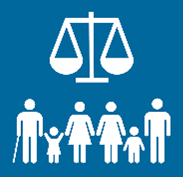SDG 16 Indicators
SDG 16 Indicators
In the 2030 Agenda, the General Assembly tasked the United Nations Statistical Commission, represented by Member States’ National Statistical Offices, to create the Inter-Agency and Expert Group on Sustainable Development Goals Indicators (IAEG-SDGs), which would be tasked with developing a Global Indicators Framework on the Sustainable Development Goals and targets. The IAEG-SDGs then developed a framework containing a set of 231 unique indicators, including 23 for SDG 16. These were adopted at the 48th session of the United Nations Statistical Commission in March 2017 and by the General Assembly on 6 July 2017.
Throughout 2019 the IAEG-SDGs conducted a Comprehensive Review of the global indicator framework with the aim to submit its proposed refinements, revisions, replacements, additions and deletions to the 51st session of the United Nations Statistical Commission in March 2020 for its consideration. In this review, SDG 16 gained one new indicator: indicator 16.3.3 on access to formal dispute resolution mechanisms.
The now 24 indicators for SDG 16 are spread across target areas and, in most cases, there are 2-4 indicators for each target area. Each of these indicators, as with all global indicators in the SDGs, has a designated custodian agency which is responsible for the methodological development and ongoing refinement of the indicator; collecting data from national statistical systems and UN regional commissions; coordinating data and information to inform the annual global SDG progress report; providing metadata for the indicator; contributing to statistical capacity building; and coordinating with other agencies and stakeholders who are interested in contributing to the indicator development and refinement. Each of the 24 indicators is categorised into three tiers on the basis of their level of methodological development and the availability of data at the global level. There are six tier 1 indicators, seventeen tier 2 indicators, and 1 indicator with multiple tiers, classified as follows:
- Tier 1: Indicator is conceptually clear, has an internationally established methodology and standards are available, and data are regularly produced by countries for at least 50 percent of countries and of the population in every region where the indicator is relevant.
- Tier 2: Indicator is conceptually clear, has an internationally established methodology and standards are available, but data are not regularly produced by countries.
- Tier 3: No internationally established methodology or standards are yet available for the indicator, but methodology/standards are being (or will be) developed or tested (As of the 51st session of the UN Statistical Commission, the global indicator framework does not contain any Tier III indicators).
The SDGs must be both globally comparable and nationally relevant. The 2030 Agenda encourages the development of regional and national indicators to complement the global ones where needed and in alignment with national priorities. As many countries are challenged in integrating global SDG indicators into national monitoring systems and in meeting the full data needs by 2030, they develop indicators to improve SDG data availability and monitoring, notably through proxy indicators or alternative sources, when these are available. It is also recognized that, in several cases, not all the multiple aspects of the targets are addressed by the global indicators and that countries should complement the global indicators with additional nationally relevant indicators. This nationalization of SDG indicators is not a one-off event, but rather a process. In addition, many researchers, international organisations, civil society actors and governments have developed and have been using indicators to measure progress on peace, justice and inclusion over the past decades.
| Tier | Custodian Agency | |||
 |
|
Indicator 16.1.1: Number of victims of intentional homicide per 100,000 population, by sex and age | 1 | UNODC WHO |
| Indicator 16.1.2: Conflict-related deaths per 100,000 population, by sex, age and cause | 2 | OHCHR | ||
| Indicator 16.1.3: Proportion of population subjected to (a) physical violence, (b) psychological violence and (c) sexual violence in the previous 12 months | 2 | UNODC | ||
| Indicator 16.1.4: Proportion of population that feel safe walking alone around the area they live | 2 | UNODC | ||
 |
Target 16.2: End abuse, exploitation, trafficking and all forms of violence against and torture of children |
Indicator 16.2.1: Proportion of children aged 1–17 years who experienced any physical punishment and/or psychological aggression by caregivers in the past month | 2 | UNICEF |
| Indicator 16.2.2: Number of victims of human trafficking per 100,000 population, by sex, age and form of exploitation | 2 | UNODC | ||
| Indicator 16.2.3: Proportion of young women and men aged 18–29 years who experienced sexual violence by age 18 | 2 | UNICEF | ||
 |
Target 16.3: Promote the rule of law at the national and international levels and ensure equal access to justice for all |
Indicator 16.3.1: Proportion of victims of violence in the previous 12 months who reported their victimization to competent authorities or other officially recognized conflict resolution mechanisms | 2 | UNODC |
| Indicator 16.3.2: Unsentenced detainees as a proportion of overall prison population | 1 | UNODC | ||
| Indicator 16.3.3: Proportion of the population who have experienced a dispute in the past two years and who accessed a formal or informal dispute resolution mechanism, by type of mechanism | 2 | UNODC, UNDP, OECD | ||
 |
Target 16.4: By 2030, significantly reduce illicit financial and arms flows, strengthen the recovery and return of stolen assets and combat all forms of organized crime |
Indicator 16.4.1: Total value of inward and outward illicit financial flows (in current United States dollars) | 2 | UNODC, UNCTAD |
| Indicator 16.4.2: Proportion of seized, found or surrendered arms whose illicit origin or context has been traced or established by a competent authority in line with international instruments | 2 | UNODC, UNODA | ||
 |
Target 16.5: Substantially reduce corruption and bribery in all their forms |
Indicator 16.5.1: Proportion of persons who had at least one contact with a public official and who paid a bribe to a public official, or were asked for a bribe by those public officials, during the previous 12 months | 2 | UNODC |
| Indicator 16.5.2: Proportion of businesses that had at least one contact with a public official and that paid a bribe to a public official, or were asked for a bribe by those public officials during the previous 12 months | 1 | World Bank, UNODC | ||
 |
Target 16.6: Develop effective, accountable and transparent institutions at all levels |
Indicator 16.6.1: Primary government expenditures as a proportion of original approved budget, by sector (or by budget codes or similar) | 2 | World Bank |
| Indicator 16.6.2: Proportion of population satisfied with their last experience of public services | 2 | UNDP | ||
 |
Target 16.7: Ensure responsive, inclusive, participatory and representative decision-making at all levels |
Indicator 16.7.1: Proportions of positions in national and local institutions, including (a) the legislatures; (b) the public service; and (c) the judiciary, compared to national distributions, by sex, age, persons with disabilities and population groups | 1 and 2 | IPU, UNDP |
| Indicator 16.7.2: Proportion of population who believe decision-making is inclusive and responsive, by sex, age, disability and population group | 2 | UNDP | ||
 |
Target 16.8: Broaden and strengthen the participation of developing countries in the institutions of global governance |
Indicator 16.8.1: Proportion of members and voting rights of developing countries in international organizations | 1 | DESA/FSDO |
 |
Target 16.9: By 2030, provide legal identity for all, including birth registration |
Indicator 16.9.1: Proportion of children under 5 years of age whose births have been registered with a civil authority, by age | 1 | UNSD, UNICEF |
 |
Target 16.10: Ensure public access to information and protect fundamental freedoms, in accordance with national legislation and international agreements |
Indicator 16.10.1: Number of verified cases of killing, kidnapping, enforced disappearance, arbitrary detention and torture of journalists, associated media personnel, trade unionists and human rights advocates in the previous 12 months | 2 | OHCHR |
| Indicator 16.10.2: Number of countries that adopt and implement constitutional, statutory and/or policy guarantees for public access to information | 2 | UNESCO-UIS | ||
 |
Target 16.a: Strengthen relevant national institutions, including through international cooperation, for building capacity at all levels, in particular in developing countries, to prevent violence and combat terrorism and crime |
Indicator 16.a.1: Existence of independent national human rights institutions in compliance with the Paris Principles | 1 | OHCHR |
 |
Target 16.b: Promote and enforce non-discriminatory laws and policies for sustainable development |
Indicator 16.b.1: Proportion of population reporting having personally felt discriminated against or harassed in the previous 12 months on the basis of a ground of discrimination prohibited under international human rights law | 2 | OHCHR |
Core resources for SDG 16 Indicators
Photo credit: @UNDP Bhutan
















